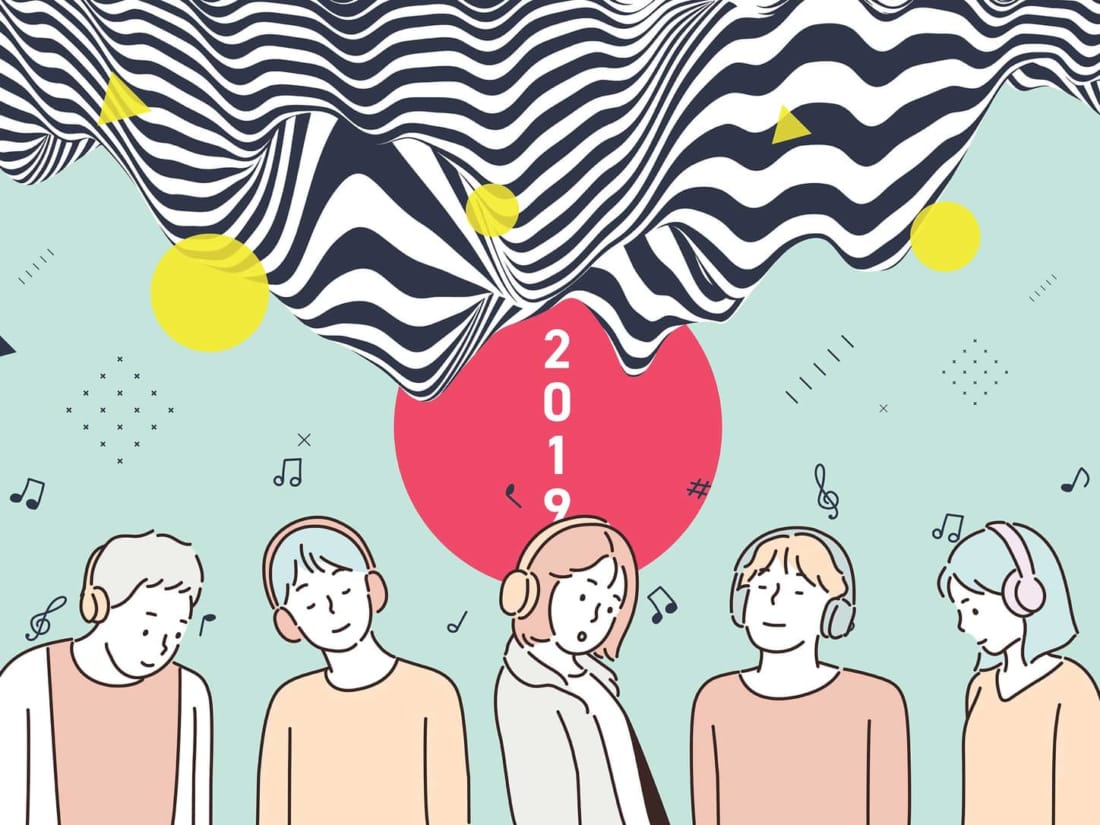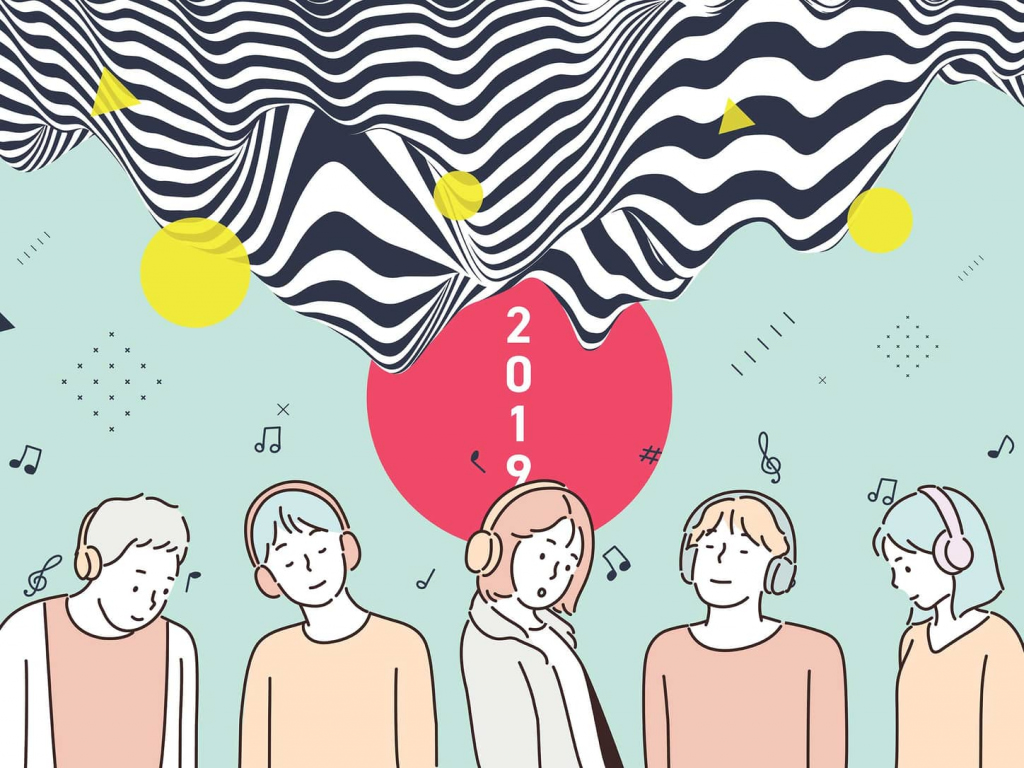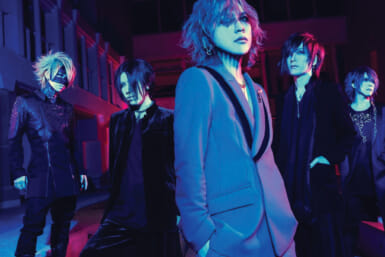
Seeing off the end of a decade and beckoning in a new era, Japanese music has never been so widespread and influential as it has been in 2019. The year after domestic album sales first dropped below 100 million, Japanese music has nevertheless flooded streaming services and artists both old and new have become more far-reaching and accessible.
In that context, there have been plenty of phenomenal releases from across the musical spectrum, from punk to dream pop, ambient to jazz. These are my 10 favorite albums released by Japanese artists in 2019.
10) Asuna and Jan Jelinek, ‘Signals Bulletin’
(Faitiche)
A collaborative project between German experimental electronic musician Jan Jelinek and Japanese ambient-drone artist Asuna, Signals Bulletin is some of the most engrossing work that either artist has put out in years. Neither of them seem keen to hop on the current bandwagon of making overly mobile ambient-drone music solely intended for Spotify “study playlists.” Instead, this is a solemn and thoughtful exercise; working bits of glitch, minimal synth and field recordings into Asuna and Jelinek’s usual respective drone and minimal electronica. Signals Bulletin always moves at a glacial pace but rewards most when it blooms into something spectral or entrancing. Signals Bulletin might not be quite as blood-pumping as some of the other records in this list, but it makes up for it with its precise, almost academic experimentalism, and Asuna and Jelinek deserve recognition for continuing to make such subtly intelligent and thought-provoking electronic music.
9) Chai, ‘Punk’
(Otemoyan)
Chai broke onto the punk scene in 2017 with Pink, a record pedestaled by a formidable, raucous bass-drum combo and a neon sheen crowned “neo-kawaii.” Hyperactive, colorful melodies are again the mainstay of Punk, while that rhythm section still drives the record. Employing polished synths and far more obvious nods to conventional J-pop, Punk is more dance punk than pure punk. Though traditional punk instrumentation may seem buried under catchy hooks, poppy synths and colorful melodies, the punk mentality is more prevalent than ever. Chai continue to challenge preconceptions of kawaii through ramping up the contradictions between pop and something much rawer, never far from more straightforward chord progressions and instrumental unruliness. Though the oddity manifest in every inch of Punk is easily overlooked, take a step back and behind all of Chai’s relentless likeability and fanatical fun are plenty of chaotic musical experiments worthy of one of Japan’s most innovative pop acts.
8) Minyo Crusaders, ‘Echoes of Japan’
(Mais Um)
Truly contemporary minyo (traditional Japanese folk music) is rare to find. Yet, led by Katsumi Tanaka, the Minyo Crusaders turn their heads to styles as diverse as Colombian cumbia, Latin funk and reggae in an effort to rework minyo into something more modern, worldly and danceable. A 10-piece band of excellent musicians, their debut Echoes of Japan is by no means short on scale or finesse. Every track is performed faultlessly, no matter the style, the Crusaders maintaining traditional minyo singing throughout and ensuring that such a vast array of influences aren’t just a gimmick but treated respectfully. Echoes of Japan is an exemplary, bold example of cross-cultural fusion done correctly.
7) Shinichiro Yokota, ‘I Know You Like It’
(Far East)
One of the year’s most joyous deep house records, Shinichiro Yokota’s simplicity and clarity of production is a welcome surprise for a genre that can be so immersed in its own self-seriousness that it forgets to keep the dancefloor moving. Yokota has long been a veteran of Japanese house but, unlike his friend and mentor Soichi Terada, he’s gone rather unnoticed outside of Japan. I Know You Like It collects tracks both old and new, seeing Yokota getting the praise he deserves as an impressively consistent and essentially distinctive performer. His naive and unpretentious approach to house music is reminiscent of the genre’s original hip-flinging intentions: stylistically, Yokota is far more concerned with ear-worming, danceable melodies than overly subtle, layered ones. I Know You Like It is indelibly tinged with the cheesy levity of Euro-house subgenres Italo-Disco and Balearic Beat but also brings the urban lights and strutting beats of Yokota’s legendary live sets to life. There are few vibes quite like it, and the results prove too tempting for even the most obstinate of dancers.
6) Otoboke Beaver, ‘Itekoma Hits’
(Damnably)
Who would have thought that the most manic, furious hardcore punk album of 2019 would have come out of a place so serene and sleepy as Kyoto? Taking their name from a love hotel in Osaka, Otoboke Beaver’s debut Itekoma Hits has gained a reputation for its stylistic versatility and topical themes. Focusing on women’s liberation, their collective frustration with love and personal relationships, and numerous social and political issues, Otoboke Beaver’s trademark gang vocals and stylistic nods to noise rock and post-punk fuel their anger. The outcome is exactly what a punk album should be: an experience that feels anything but pacifying, like a succession of 14 jolting electrocutions stirring one into action against misogynistic men and stifling social values. Itekoma Hits is a direct, topical, boisterous punk record made for the modern age and proves that Japan remains the source of some of the genre’s most prolific and incisive artists.
5) Dos Monos, ‘Dos City’
(Deathbomb Arc)
The Tokyo-based rap trio of Botsu, Taitan Man and Zo Zhit, collectively known as Dos Monos, pride themselves on being outsiders. And it’s easy to see why. Everything about Dos City, their debut album, feels chaotic, disorientating and like little else. From the widely-sourced samples and cluttered, cacophonous beats to the overlapping flows and bilingual, coded lyrics, Dos Monos play with influences and styles faster and more loosely than anyone else.
Clearly heavily indebted to ’90s American hip hop (specifically that of Wu-Tang Clan and their associates), the trio also claim influences as wide as The Mars Volta, Animal Collective, Madlib and Flying Lotus. While that melting pot might seem wild and disassociated, Dos Monos harness those influences immaculately into a somewhat coherent (yet still abstract) statement and, for all their historical stylistic heroes, they sound quintessentially contemporary. Few are bringing boom bap and hardcore hip hop into the 2020s with such style, and Dos Monos are making some of the finest Japanese hip hop out there.
4) Ayano Kaneko, ‘Sansan’
(1994)
Ayano Kaneko has been writing excellent indie pop songs for years, but Sansan is her most ambitious, complex and fully realized effort to date. Kaneko’s newfound home of indie folk (rather than her previous pop rock) allows her to fully show off her songwriting talent and knack for melody, embellishing her tunes with extra instrumentation like horns, synths, banjos and backing singers. Featuring Kaneko’s distinctively omnipotent vocals and her trusty acoustic guitar riffs, Sansan blossoms with bright and upbeat songs that occasionally even reference surf rock or railroad folk. The work as a whole feels like the project that Kaneko has been building towards over the past five years or so and is satisfyingly culminative and ambitious from one of indie pop’s standout performers.
3) Yosi Horikawa, ‘Spaces’
(Borrowed Scenery)
Intelligent Dance Music (IDM) is a pretty pretentious, elitist and altogether ridiculous name for a genre. Sometimes, however, a record comes along which, given the illustrious names littered throughout history of IDM, can’t be described as anything else. Yosi Horikawa’s Spaces certainly fits that mold; electronic music made by a man known for travelling to obscure corners of the globe to record his own field samples and then fusing them with beats and other instrumental inspirations.
What makes Horikawa so fitting for IDM is just how technical and unique his music feels. I’ve never quite heard field samples used in the same way as Horikawa on Spaces. They form the basis of every track, more prominent than their use by the likes of other IDM pioneers Boards of Canada and more rhythmic and human than most electronica. Horikawa underlays every track with these samples, occasionally spinning through them with minimalist instrumental phases, effectively merging electronica with the sounds and sights of the real world.
And what’s even more odd about Spaces is how rewarding it is. This isn’t just an opaque collection of sound experiments but an album that is frequently beautiful and –occasionally – even danceable. IDM was never meant for purpose in clubs, and yet the rhythms and sample manipulation here are inherently catchy; Spaces is the work of a true sound design artist yet it’s also approachable. Not only does it highlight Horikawa as one of the most exciting names in electronic music, but it seems no stretch at all to mark Spaces out as one of the most atmospheric electronic albums ever released and a pinnacle in the genre.
2) 3776, ‘Saijiki’
(Natural Make)
Don’t let Ide Chiyono’s playful impersonation of Mount Fuji on the cover disarm you into thinking that Saijiki is anything other than a progressive pop epic. Consider this trimmed-down interpretation of its liner notes, in which it is revealed as far more than merely a modern take on a very literal saijiki (or year-time-chronicle) by a Fuji-idolizing pop outfit:
“All song titles follow the form, ‘month, tempo, key,’ with all 12 tracks together being considered a year. Each month is also expressed with a fixed tempo and key. The length of each track is fixed. Months with 31 days are 6 minutes and 12 seconds long, months with 30 days are 6 minutes long, and so on. Each second within this album is counted, similar to a metronome. The words said each second are the 12 names of the Zodiac signs. Each track is not exactly one song but many; though there are 12 tracks, there are 31 songs, all in one continuous mix. One year is 12 months, and one octave is 12 semitones, thus a fixed key can be assigned to each month. For example, the first track is in F major, meaning every song contained is F major, and with each track, the key increases by one semitone.”
That’s a lot to take in. The composition of Saijiki (instrumentally masterminded by Akira Ishida) is so intensely calculated and detailed that it verges on neurotic. Not only does it measure everything from the seconds, tempos and key changes, but it merges Japanese folk and nursery rhymes with European classical movements, field recordings and other elements of experimental pop like glitch and deconstructed electronica. And it works, terrifically well. Though so dense it often feels like one can never truly extract everything from Saijiki, its exceptionally high-quality production makes every maximalist statement audible. It’s easy to admire the difficulty and creativity involved in only the concept of a record like this, but it’s even more impressive how natural the results sound. Saijiki is so remarkable in that its concept is so restrictive and yet it sounds entirely boundless. It’s as exciting as pop music gets and rather easily one the most progressive and ambitious records of 2019.
1) Sakanaction, ‘834.194’
(Victor Entertainment)
Very rarely does pop music make for compelling double albums. Double albums can feel bloated and samey; an excessive number of tracks hinting that artists’ egos have taken hold and perhaps they haven’t undergone quite enough post-production trimming. Some of the very finest double albums have escaped such extravagance (like The White Album or The Wall) but, for the most part, they’re more often considered somewhat flawed; requiring a certain amount of compromise given their length and stylistic variation.
834.194, this year’s colossal record from legendary pop all-rounders Sakanaction (and their first since 2013), not only dispels with the idea that a double album of pop music is necessarily flawed but does so as the band’s finest work yet. Named after the kilometrical distance between their hometown in Hokkaido and their studio in Tokyo, the scale of 834.194 feels every bit as huge as that physical difference. Alone, the influences and genres referenced include synth-funk, electro-pop and synthpop, as well as bits of Europop, nu-disco, funk rock, pop rock, new wave and EDM, alongside Sakanaction’s usual dance rock and electronica.
And yet, despite that breadth of variation, there is little about 834.194 that feels surplus to its overall mission as a collection of stellar pop tunes. It’s remarkably consistent and superbly paced, despite not only being lengthy overall but typically containing lengthy individual songs. It’s a testament to just how phenomenal a songwriter Ichiro really is that every track on 835.194 is an attraction unto itself. Every riff, every vocal melody, every instrumental phase; even tracks that some would usually consider filler (like the remix of ‘ユリイカ’ and instrumental ‘834.194’) are instead essential listens that genuinely bring something new to the disc.
834.194 is, therefore, a rare breed. It’s a double album that doesn’t force compromise as something that is lengthy, expansive and overreaching but impresses as a collection of exquisite pop tracks. It’s a terrific album, sure to go down as one of Sakanaction’s defining releases and one of the best albums of the year.










